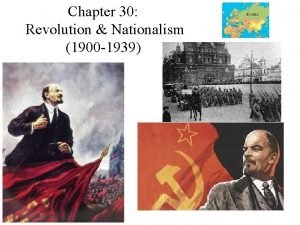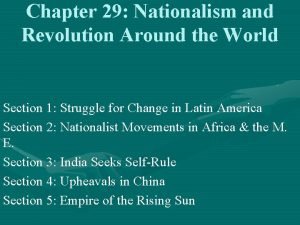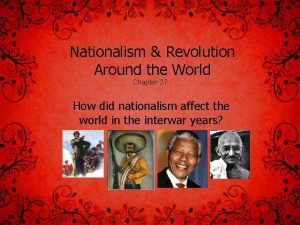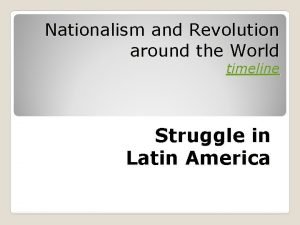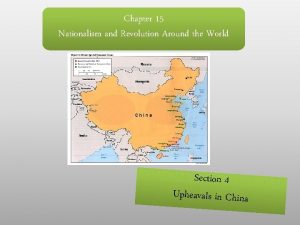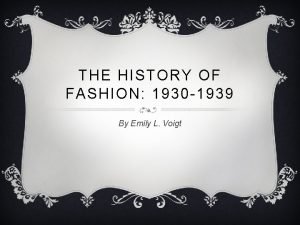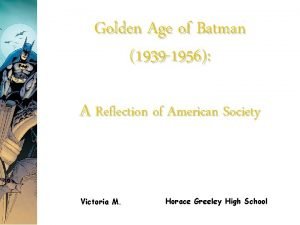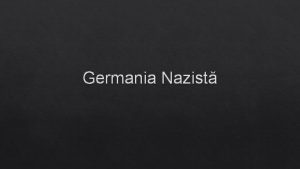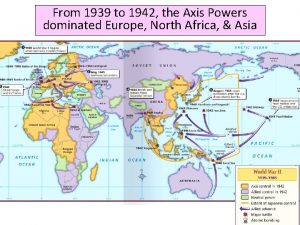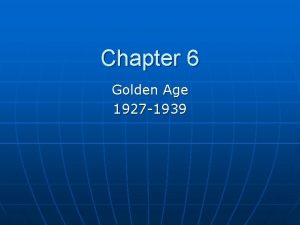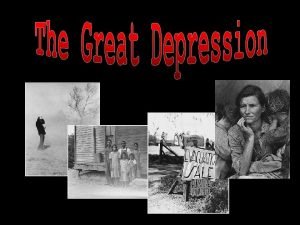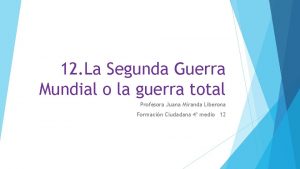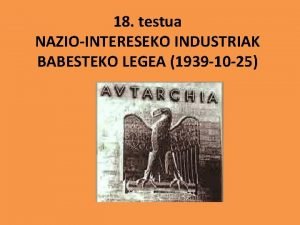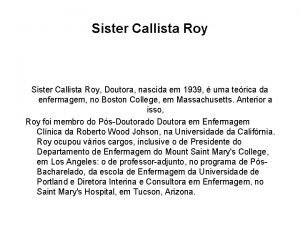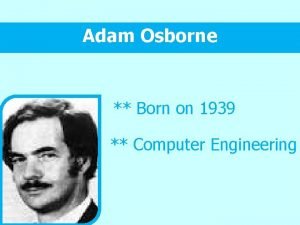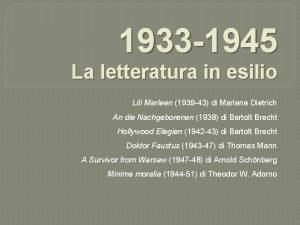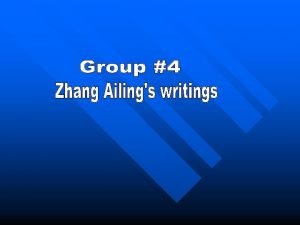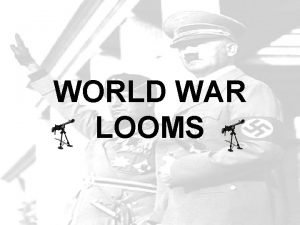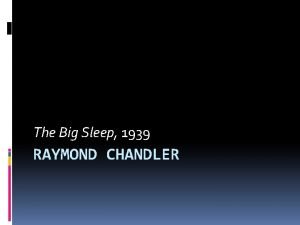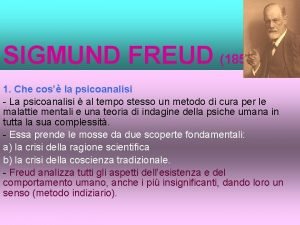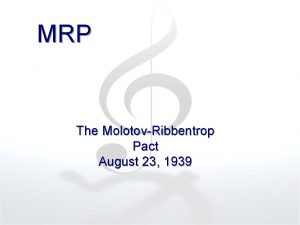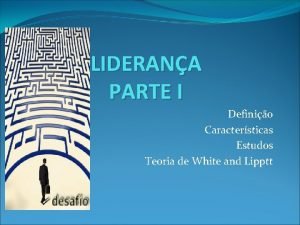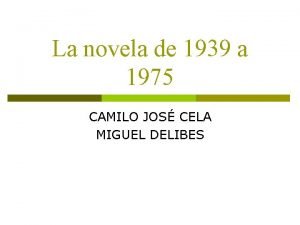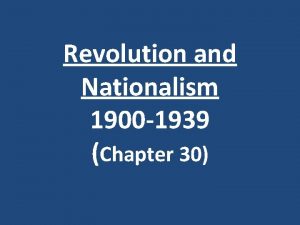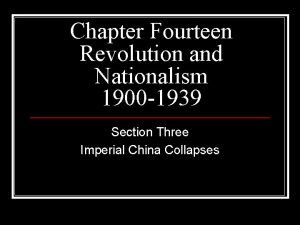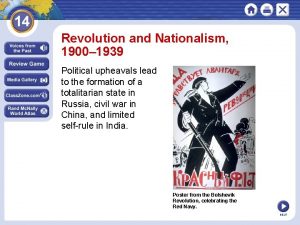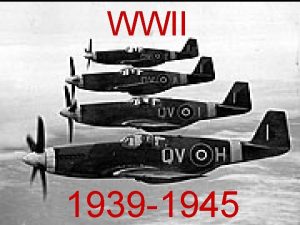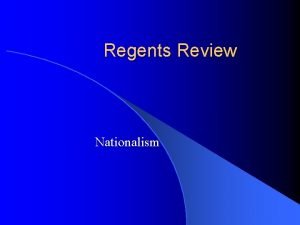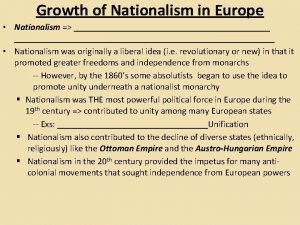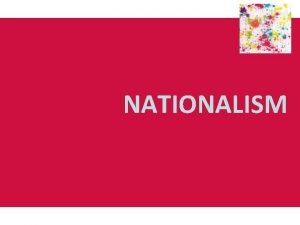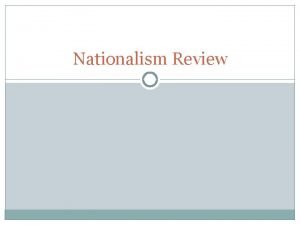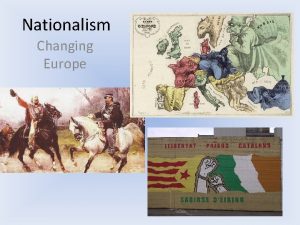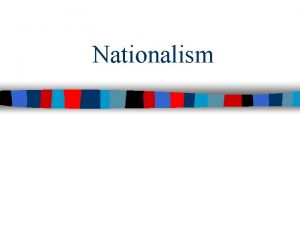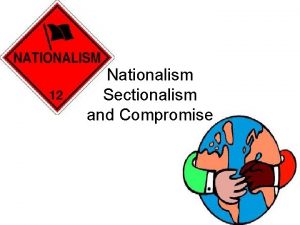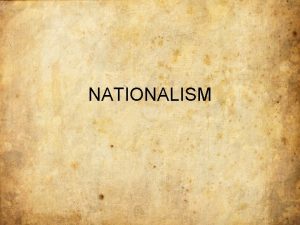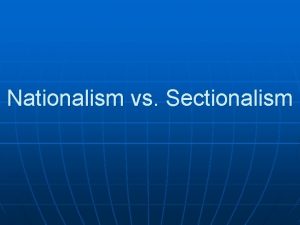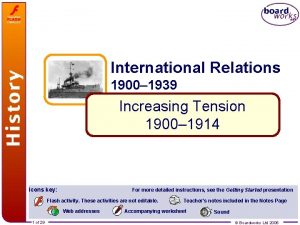Chapter 30 Revolution Nationalism 1900 1939 Chapter 30



































- Slides: 35

Chapter 30: Revolution & Nationalism (1900 -1939)

Chapter 30 Russia Revolution Vocabulary 15 Chapter 30 Russian Revolution Vocabulary Your Table of Contents (TOC) MUST be updated with each Must include: assignment. • Vocabulary word 1. ) p. 868 proletariat: workers in Russian that will take over Russia • Definition • Page number • Number the words Chapter 30 Russian Revolution Vocabulary 16

Chapter 30 Vocabulary Words 1. ) proletariat p. 868 Pages 15 & 16 in your 2. ) Bolsheviks p. 868 Interactive Notebooks 3. ) Soviets p. 870 4. ) provisional government p. 870 5. ) communism p. 737 Must include: 6. ) totalitarianism p. 875 • Vocabulary • Page number • Number the word 7. ) propaganda p. 854 words • Definition 8. ) Great Purge p. 876 9. ) command economy p. 877 Today is the only day you 10. ) collective farms p. 878 will have in class just for vocabulary!

Section 1: Revolutions in Russia • The Russian Revolution was like a firecracker with a very long fuse. • The explosion came in 1917, yet the fuse had been burning for nearly a century. • The cruel, oppressive rule of most of 19 th century czars caused social unrest for decades. • Army officers revolted in 1825. • Secret revolutionary groups plotted to overthrow the government. • In 1881, revolutionaries angry over the slow pace of political change assassinated the reformminded czar, Alexander II. • Russia was heading toward a full-scale revolution.

Czars Resist Change • In 1881, Czar Alexander III succeeded his father Alexander II, and halted all reforms in Russia. • Alexander III clung to the principles of autocracy, a form of government in which he had total power. • Anyone who questioned the absolute authority of the czar, worshiped outside the Russian Orthodox Church, or spoke a different language other than Russian was labeled as dangerous.

Czars Continue Autocratic Rule • To wipe out revolutionaries, Alexander III used harsh measures: – imposing strict censorship codes on publish materials and written documents – using a secret police to watch both secondary schools & universities (Why here? ) – sending political prisoners to Siberia • To establish a uniform Russian culture, he oppressed other national groups within Russia. • Russian was made the official language of the empire and use of minority language was forbidden. • Also, Alexander made Jews the target of persecution. • A wave of programs- organized violence against Jews- broke out in many parts of Russia.

Alexander III Nicholas II Olga Tatiana Alexandra Nicholas’ wife Marie Anastasia Alexie

The Fates of Czar Nicholas II, Alexandra, & Rasputin • When Nicholas II became czar in 1894, he continued the tradition of Russian autocracy. • He was considered a weak, inefficient, & ineffective czar. • Czarina Alexandra was even more blindly committed to autocracy than her husband & rumors mentioned how she influenced his decisions. • In 1915, Nicholas moved his headquarters to the war front and Czarina Alexandra ran the government in his place. • She ignored the czar’s chief advisors and fell under the influence of a self-described “holy man”, named Rasputin.

The Fates of Czar Nicholas II, Alexandra, & Rasputin • When Nicholas and Alexandra’s son, Alexis, fell ill, Rasputin seemed to ease the boys symptoms. To show her gratitude, Alexandra allowed Rasputin to make key political decisions. • Rasputin opposed reform and obtained power positions for his friends. • In 1916, a group of nobles murdered Rasputin because they feared his increasing role in governmental affairs. • July 17, 1918: All of Czar Nicholas’ family was tricked into the cellar of a house where the Bolsheviks fired bullets into the house until everyone was dead. They tried to destroy the bodies with fire and sulfuric acid.


• Rapid industrialization changed the Russian economy. • The number of factories more than doubled from 1863 -1900, but Russia was still behind Western Europe. • In the 1890 s, Nicholas II’s most capable minister launched a new program. • To finance the build up of Russian industries, the government sought foreign investment & raised taxes. • These steps boosted the growth of heavy industry, Russia particularly steel. Industrializes • By 1900, Russia was the world’s fourth largest steel producer. • In 1891, work began on the world’s longest continuous rail line: the Trans-Siberian Railway. • The railway was not complete until 1916. • It connected European Russia in the west with Russian ports on the Pacific Ocean in the east.

The Revolutionary Movement Grows • The growth of factories brought new problems to Russia: – poor working conditions – low wages – child labor – government outlawing trade unions • Workers organized strikes. • Several revolutionary movements began to grow and compete for power. • Karl Marx established a following • They believed the industrial class of workers would overthrow the czar. • These workers would then form “a dictatorship of the proletariat. ” • This meant the proletariat- workers- would rule the country.

Mensheviks, Bolsheviks, & Lenin • In 1903, Russian Marxists split into two groups over revolutionary tactics. – moderate Mensheviks wanted a broad base of popular support for the revolution – more radical Bolsheviks supported a small number of committed revolutionaries willing to sacrifice everything for change • The majority leader of the Bolsheviks was Vladimir Ilyich Ulyanov. He adopted the last name of Lenin. • Vladimir Lenin had an engaging personality, was an excellent organizer, & was very ruthless. • These traits helped him gain control of the Bolsheviks. • In the early 1900 s, Lenin fled to western Europe to avoid arrest by the czarist regime. • For there he maintained contact with other Bolsheviks and waited until he could return safely to Russia.

Crisis at Home and Abroad • Between 1904 and 1917, Russia faced a series of crises that showed the czar’s weakness & paved the way for revolution. a. ) The Russo-Japanese War b. ) Bloody Sunday c. ) World War I

The Russo-Japanese War • In the late 1800 s, Russia & Japan competed for control of Korea & Manchuria. • The two nations signed a series of agreements over the territories, but Russia broke them. • Japan retaliated by attacking the Russians. • News of repeated Russian losses sparked unrest at home and led to a revolt in the midst of the war.

• On January 22, 1905, about 200, 000 workers and their families approached the czar’s Winter Palace in St. Petersburg. • They petitioned for: – better working conditions – more personal freedom – an elected national legislature • Nicholas II’s generals ordered soldiers to fire on the crowd – more than 1000 were wounded – several hundred were killed • Bloody Sunday provoked a wave of strikes & violence that spread across the country. Bloody Sunday: The Revolution of 1905 • In October 1905, Nicholas promised more freedom & approved the creation of the Duma- Russia’s first parliament. • The first Duma met in May 1906 and its leaders wanted Russia to become a constitutional monarchy like Britain. • But because he was hesitant to share power, the czar dissolved the Duma after 10 weeks.

World War I: The Final Blow • In 1914, Nicholas II made the decision to drag Russia into WWI. • Russia was unprepared for war financially. • With weak generals and poorly trained troops, it was no match for the Germans. • Before a year had passed more than 4 million Russian soldiers had been killed, wounded, or taken prisoner. • Russia’s involvement in WWI revealed the weakness of czarist rule and military leadership. • By 1917, the Russian will to continue fighting in the war had disappeared.

Trouble at the War Front & Home Front • Meanwhile on the war front Russian troops mutinied, deserted, or ignored orders. • On the home front, food and fuel supplies were dwindling and prices were inflated. • People from all classes wanted change and to end the war.

The March Revolution Questions Directions: on p. 18 of your notebooks answer the following questions in complete sentences (pages 869 -873) 1. ) Summarize what happened with the March Revolution discussed on pages 869 -870. 2. ) What happened to the provisional government? Which person now takes over? 3. ) What groups made up the Red Army & the White Army? What desire united the White Army? 4. ) What did the Bolsheviks rename their party to? Why did they rename it that? 5. ) Which events of the czarist rule do you think was most responsible for the fall of the czar?

Stalin Becomes Dictator • After Lenin suffered a stroke in 1922 there is a competition for leading the Communist Party – Leon Trotsky – Joseph Stalin • Stalin was cold, hard, and impersonal. • Stalin began his ruthless climb to the head of the government between 1922 and 1927. • As general secretary of the Communist Party, he worked behind the scenes to move his supporters into positions of power. • Lenin believed Stalin was a dangerous man. • Lenin died in 1924. • By 1928, Stalin was in total command of the Communist Party. • Trotsky was forced into exile in 1929 and was no longer a threat. He was exiled to Mexico, where he was killed in 1940, probably on Stalin’s orders.

Stalin as Dictator • Stalin dramatically transformed the government of the Soviet Union. • Stalin’s goal was to make the Soviet Union as politically & economically strong as the most powerful nations of the world. • Totalitarian tactics: – Great Purge: rid himself of opposition – propaganda & censorship – religious persecution – education & indoctrination – worked to establish total control of all aspects of life in the Soviet Union • the government • the economy; command economy • many aspects of citizens’ private lives.

Totalitarianism • Create a Bubble Map using p. 875 and our discussion of Totalitarianism • Use the paper provided. • Answer the Frame Guiding Question, too!


Totalitarianism With your table partner spend 2 minutes discussing how your life would change if you lived in a totalitarian state. Be prepared to share out an answer for each of you.

Stalin’s Totalitarian State • Complete graphic on your worksheet from Friday by filling in TWO details for each bubble. • Use pages 876879. • This is page 19 in your interactive notebook.

What is Propaganda? Propaganda: ideas, facts, or allegations spread deliberately to further one's cause or to damage an opposing cause; often political 7 Types of Propaganda 1. 2. 3. 4. Transfer 5. Testimonial 6. Glittering Generalities 7. Plain Folks Bandwagon Name Calling Card Stacking

Transfer • Transfer uses images to bring up strong feelings in order to persuade. • “A picture is worth a thousand words” • Transfer works because you transfer the happy feelings you associate with a picture to happy feelings you have about a person or a product. What feelings does this picture represent? What product are we supposed to transfer these feelings to? Even though Coca Cola has nothing to do with Christmas, we are supposed to transfer the happy feelings of Christmas to the product.

Testimonial works because you feel like you can trust the words of an expert or a famous person. Who are you supposed to trust in this advertisement? Who is the expert in this testimonial?

Glittering Generalities • Glittering generalities persuade by using positive words to arouse thoughts, actions, or emotions. • Glittering generality works because the words make you feel happy and positive. What words in this advertisement make it glittering generality?

Plain Folks What does she want people to do? • Plain folks often uses people to attempt to convince others that they, and their ideas, are “of the people”. • They make every day, plain folks feel like they are part of something that everyone is a part of, too.

Bandwagon • Persuading people to do something by letting them know others are doing it and they should do it also. • Uses sayings such as, “everyone else is doing it” or “it could work for you too. ” Why is this an example of BANDWAGON?

Name Calling • Name calling persuades people by using negative words to foster dislike, hate, or fear for a product or idea. • Name calling works because the words make you think twice about the product or idea because it is hated or feared. How is this advertisement using name calling? What is this advertisement urging you NOT to buy?

Card Stacking Why is this advertisement an example of card stacking? • Card stacking persuades people by giving false facts, rearranging facts, or withholding the real facts to “slant” the picture in a certain direction. • It makes you think you are getting something great, but there are hidden disclaimers.

Create a Poster with a Partner! 1. ) Create a propaganda poster that Stalin’s Totalitarian State might use to further their agenda. Be sure to include: § At least one picture with color § Write a slogan/phrase for it Hint: Start by deciding what Stalin wants people to do 2. ) On the back: a. ) Describe the goal of the poster. b. ) Which of the 7 techniques is used? c. ) Explain why this poster would be effective. § Transfer § Testimonial § Glittering Generalities § Plain Folks § Bandwagon § Name Calling § Card Stacking

Russian Revolution Test Review Bonus points for turning in your Bonus points review sheet Monday before the test. 1. ) Know all of your vocabulary! 2. ) Know your people! Czars, leaders, etc… 3. ) What problems happened with rapid factory growth? (4) 4. ) Russo-Japanese War, Bloody Sunday, & World War I: What are they? How did they lead to the final revolution? 5. ) What was the goal of the 5 Year Plan? 6. ) Which event(s) of the czarist rule do you think was most responsible for the fall of the czar? Provide details to support your claim. Answer in complete sentences. 7. ) Describe Stalin's Totalitarian State. What policies did he use? What methods did he use to make it totalitarian? Provide two specific examples in your description. (p. 19 in notebook)
 Revolutionary leaders 1900-1939
Revolutionary leaders 1900-1939 Russian revolution vocabulary
Russian revolution vocabulary Nationalism and revolution around the world
Nationalism and revolution around the world Nationalism and revolution around the world
Nationalism and revolution around the world Nationalism and revolution around the world
Nationalism and revolution around the world Nationalism and revolution around the world
Nationalism and revolution around the world Russian revolution vs french revolution
Russian revolution vs french revolution You should hope this game will be over soon
You should hope this game will be over soon Third agricultural revolution
Third agricultural revolution Ann arbor mi population pyramid
Ann arbor mi population pyramid 1930-1939 fashion
1930-1939 fashion Poland population 1939
Poland population 1939 Shingelfrisyren
Shingelfrisyren The golden age (1939-1956)
The golden age (1939-1956) Harta germaniei 1939
Harta germaniei 1939 Who dominated europe, north africa and asia from 1939-1942?
Who dominated europe, north africa and asia from 1939-1942? Golden age of aviation 1927-1939
Golden age of aviation 1927-1939 1939 market crash
1939 market crash Mapamundi 1939
Mapamundi 1939 1939
1939 Nazio-intereseko industriak babesteko legea (1939-10-25)
Nazio-intereseko industriak babesteko legea (1939-10-25) Teoria da adaptação callista roy slide
Teoria da adaptação callista roy slide Computer 1939
Computer 1939 Bahn signallampe 1939
Bahn signallampe 1939 Henri matisse la musique 1939
Henri matisse la musique 1939 Lili marleen 1939
Lili marleen 1939 Eileen chang love in a fallen city summary
Eileen chang love in a fallen city summary St. louis ship 1939
St. louis ship 1939 Concentration camps vs internment camps venn diagram
Concentration camps vs internment camps venn diagram Toplumla sosyal hizmet uygulama modelleri
Toplumla sosyal hizmet uygulama modelleri Raymond chandler 1939
Raymond chandler 1939 Gmund freud
Gmund freud What happened on august 23 1939
What happened on august 23 1939 British empire in 1939
British empire in 1939 White e lippitt (1939)
White e lippitt (1939) Novela de 1939 a 1975
Novela de 1939 a 1975

